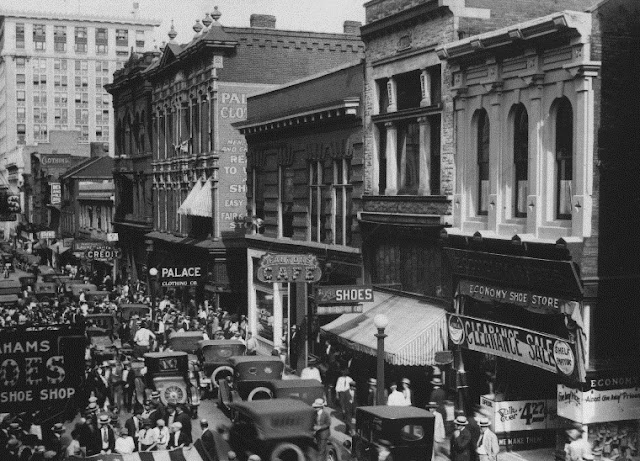Nick Fielder asked on a Facebook page, I Remember Nashville When, about the first pizza, and Mexican restaurants in Nashville. I did some searching in old newspapers and was surprised at how early ethnic restaurants were operating in Nashville. And of course, that made me want to know more. People came from all over the world to Nashville. Naturalization records at Metro Nashville Archives include persons from Italy, Germany, Russia, Bavaria, Ireland, Hungary, Poland, Switzerland, Greece, France, Scotland, Canada, and many other countries.
I am going to start with Faucon's, an early French restaurant in Nashville.
 |
| The Tennessean June 15, 1910 |
 |
| Union Street and Faucons about 1918. TSLA |
Xavier Faucon opened his business at 419 Union Street in February of 1896. Faucon was born in France and came to the U.S. when he was 14 years old. He settled in New Orleans where he married Marie Pons. In 1896 he opened a restaurant on Union Street. In 1904, Faucon turned management of the restaurant over to his son Leon and moved to Biloxi, Mississippi. Leon operated Faucon's until his death in 1926. Xavier closed the restaurant soon after saying he was tired and needed to be in Biloxi with his wife. The restaurant was known for it's famous Faucon Salad. My mother told me Faucon's Salad had a Roquefort Cheese dressing. Jimmy Kelly's has the Faucon Salad and what is said to be an authentic recipe on their menu today. Click here for Jimmy Kelly's Steakhouse Menu.
____________________________________________________________________________
Italian restaurants seemed to have been on almost every corner. Some were chili parlors or cafes and others were full-scale restaurants with varied menus. In the early 20th century there were many Italian families living in Nashville. A good number of them were musicians from the city of Viggiano. After living in Nashville a few years most of them gave up music for the grocery business or opened a restaurant or cafe. Varallo is a name that most every native Nashvillian knows, Frank Varallo, Sr. started out peddling chile from a cart downtown. In 1907 he opened his first restaurant or chili parlor.
 |
| Tony Petrucelli and Frank Varallo Sr. Subway Chili Parlor, operated by Frank Varallo, Sr. TSLA |
Nick Melfi had a chili parlor of Church Street. By the 1930's had moved to 21st Avenue and were serving American, Italian, and Chinese fare. Antonio Petrucelli opened his chili parlor on Deaderick Street in 1921 and declared himself Tony the Chili King. Tony's brother Dominick Petrucelli had a cafe on Church Street where he served breakfast lunch and dinner American style but ravioli chili and spaghetti were always on the menu.
 |
| Tony's Chili Parlor, 317 Deaderick. Nashville Banner 1956 |
Corsini's was the first to advertise the sale of pizza.
 |
| The Tennessean, January 28, 1950 |
____________________________________________________________________________
Nashville had a Greek community in the early 20th century and some of those citizens were in the restaurant business. Thomas Velaski, John Katsoulis, George Pasayan, George Callis, George Condras, James Douglas (Dubros) and George Douglas (Dubros) were all listed in the 1920 census for Nashville as proprietors of restaurants. Very little mention of these restaurants appeared in newspapers. The best know Greek restaurateurs were the owners and operators of Candyland in downtown Nashville. Angelo Anderson and his brother Sam were born in Greece with the name Theodoropoulous. The brothers along with their nephew Louis Belios founded Candyland in 1923.
 |
| Candyland, Church Street. Nashville Public Library. |
____________________________________________________________________________
The Midway Grill on 6th Avenue North may have been the first restaurant to serve authentic Chinese fare. They advertised in 1930 that a Chinese chef prepared all of the food.
____________________________________________________________________________
There was a restaurant on Church Street selling both Mexican and Chinese in 1944, but it does not seem to have been around very long.
 |
| The Tennessean, April 14, 1944. |
The first Mexican Restaurant opened in Nashville seems to be El Taco which opened in Nashville in September of 1963. In 1970 Vincente and Ernie Chaires opened an El Taco restaurant on Gallatin Road in Inglewood. The earlier El Taco did not seem to be associated the Chaires family business.
 |
| The Tennessean, September 8, 1963. |
____________________________________________________________________________
In 1905 there was a Hungarian restaurant on Union Street.
____________________________________________________________________________
There were hoards of Germans and Swiss in Nashville but I have not identified an early German restaurant. The famous Gerst House restaurant was opened in Nashville on 2nd Avenue North, in 1955 by W. M. Gerst. His daughter and her husband Gene Ritter later took over the restaurant. They operated the business until it was forced to move in 1970. The Ritters hauled all of the memorabilia across the river to 228 Woodland Street. Patrons followed and it became a favorite watering hole for lawyers and judges after a long day at the courthouse. In 1988 the restaurant was purchased by purchased by Jim and Jerry Chandler. The name was changed from Gerst House to Gerst Haus. When plans were announced to build a stadium for our Tennessee Titans, it was learned that the Gerst Haus would be relocated once again. The restaurant reopened in the summer of 2000. It was across Woodland Street from the old location on Interstate Drive. Sadly in February of 2018, the Gerst Haus was closed after more than 60 years of business.
 |
| Gerst House, 2nd Avenue North, Metro Nashville Archives. |
 |
| Gerst Haus, 2017 |












